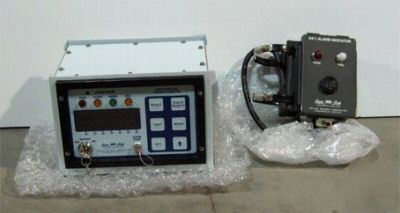Components and Parts Idea/Ad Exchange, free for members. > Bible Belt
> CNC and computerized equiptment
> Multi-purpose radiation monitor w/ smart probe support
Multi-purpose radiation monitor w/ smart probe support
* Supports up to three “SMART†probe detectors
* Portable or wall-mountable
* Six-button keypad for control of mode, display and alarm functions
* Vacuum fluorescent display, 2 x 20 character alphanumeric and bargraph
* Dose and dose rate alarms (visual and audible)
* Internal self-diagnostics with display and alarm
* 110/220 V ac, 50/60 Hz with battery backup operation
* Built-in lithium battery back-up for clock and data
* Multiple analog and digital I/O ports
* Key switch to prevent unauthorized use or changes to settings
* Stand-alone operation or computer-based system use
Model ADM606M ten decade radiation monitor is both a rate-meter and a scaler. The ADM606M supports the “SMART†probes for monitoring all types of radiation including alpha, beta, gamma, x-ray, and neutron.
Model ADM606M is microprocessor- based with an auto-ranging digital/analog display that provides both high accuracy and trending of results. This multi-detector capability allows it to be configured as an area, process or effluent monitoring system. Using “SMART†probes allows the ADM606M to automatically interrogate the probe and determine probe type and the relative operation and calibration constants. The readout display units are automatically adjusted to correspond to the probe type. The ADM606M is capable of utilizing simultaneous inputs from up to three separate “SMART†detectors.
The ADM606M has a bright, sharp vacuum fluorescent display which permits easy viewing of the radiation reading, both from a distance and at an acute angle. The use of a floating decimal point and auto-ranging units of measurement reduce the possibility of operator error when determining the amount of radiation. The type of radiation being measured is a function of the detector type (e.g., beta, gamma, neutron, etc.) and is displayed in conjunction with the radiation measurement. The display features a “scrolling†two detector display of any two user-selectable detector inputs at one time and will default to probe one during normal use. When used to display two channels, the information is digitally displayed. When a single channel is displayed, both a digital and analog bargraph are used. This allows all pertinent measurement information to be displayed as desired. Both visual and audible alarms occur when radiation levels exceed user-selectable set-points. Other user-selectable modes provide display and control functions such as accumulated dose, dose rate and scaler function. Units may be displayed in either R/hr, Ci/cc or si units (e.g., Sv/hr, Bq/l).
The ADM606M has two basic controls; a key-lock switch and a keypad. The key-lock switch provides the primary OFF/KEYPAD/ON control of the rate-meter, and incorporates a “lock out†position to eliminate tampering by unauthorized personnel. When the key-lock switch is in the KEYPAD position, the key cannot be removed and operational parameters may be modified. When the key is in the ON position, the key may be removed and the operational parameters can only be interrogated but not modified.
The input/output interface offers the user various methods to interface the ADM606M with ancillary or peripheral equipment. These various methods include relay contacts, analog outputs, and serial communications. Each High, Alert, and Fail alarm has a separate SPDT relay for interfacing to external devices. The ADM606M may be configured to operate in either of two alarm modes; alarm relay normally energized (fail-safe mode) and alarm relay not energized on alarm (non-failsafe mode). The ADM606M has three standard analog outputs which may be configured in any combination of 0-10 V dc and 4-20 mA dc. The analog outputs may be scaled either lin-log (linear between log decades) or log-log (log between log decades). The serial communications port may be used to change the algorithm from a log-lin analog output to a log-log analog output. Two serial ports are available for remote communications. These serial ports allow the ADM606M to be linked to a host computer and other ancillary and peripheral instrumentation over a bi-directional local area network. Standard communications protocol available at the serial ports is RS-485 and RS-232C. The RS-485 protocol is used for networking and moderate distance communications. The RS-232C protocol is used for limited distance communications with a recorder or a printer. It may also be used with a portable computer to do system debug diagnostics or to change stored operational data.
Historical data is stored within the memory of the ADM606M. Historical data consists of stored data points for radiation, alarms, and loss of power. Stored data includes 30 data points each of one minute, ten minute, one hour, and one-day readings. Historical data is stored in a non-volatile 16 k-Byte memory, and is backed up by a lithium battery. Each historical data point contains the measurement data and time, the data collection period, and the accumulated dose and counts. Historical data stored within the ADM606M may be downloaded to a computer for report generation or analysis.

